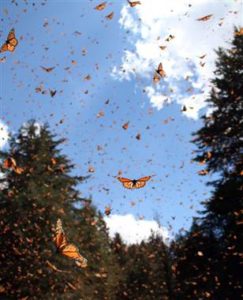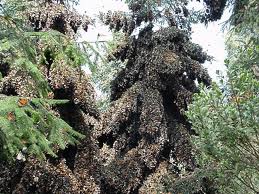My parents, like the Monarch butterflies, wintered in Central Mexico. Fleeing icy Manhattan to join their friends in Palm Beach or Palm Springs would have been too easy. Instead, after my father retired from dentistry at 80, they set up house in Ajijic, a small lake-side village outside Guadalajara with a big ex-pat community and cheap golf. For my mother, a former Macy’s executive, the mere satisfaction of explaining the correct pronunciation of Ajijic—ah-hee-heek—made it worth the many aggravations. And my husband and I, travel enthusiasts, liked the fact that taking our kids to see their grandparents each Christmas entailed a border crossing. But the visit was never easy; in fact, hanging around my parents’ house was more than any of us could bear.
As a result, the yearly attempt at connectedness in the sun always included a major excursion—a vacation from the vacation—like one year’s escape to the remote sanctuary where the butterflies have their winter roost. The idea for the outing came from my father: something to see while we still could. The Monarchs weren’t yet considered endangered, but we knew climate change and extensive logging would soon fix that. “It sounds just crazy enough for you two,” my father couldn’t resist adding. His words, traveling over telephone wire, carried along the familiar image of raised eyebrows and rolling eyes.
None of us was easygoing and the tensions that inevitably arose when we came together made the expression “nuclear family” seem like a pun. The children—Jared and his older sister Zoe—had been warring since they could walk. My psychiatrist husband, Michael, had the habit of tuning out whenever the going got rough. And my volatile parents, Edna and Leo, with 50 years of marital combat under their belts, were pushed over the edge by our laid-back parenting. As self-appointed peacekeeper, I managed only to annoy everyone. It  seemed that the moment we crossed the threshold of my parents’ lovely house, with its breath-taking view of Lake Chapala, my children turned anarchistic, my husband catatonic, and my parents combustible, while I, the superglue that should have held us all together, came unstuck after the first few hours. Constant motion was our only hope. The trip to the butterfly winter roost sounded arduous, but if the insects could do it on their tiny wings, we ought to be able to motor our way there.
seemed that the moment we crossed the threshold of my parents’ lovely house, with its breath-taking view of Lake Chapala, my children turned anarchistic, my husband catatonic, and my parents combustible, while I, the superglue that should have held us all together, came unstuck after the first few hours. Constant motion was our only hope. The trip to the butterfly winter roost sounded arduous, but if the insects could do it on their tiny wings, we ought to be able to motor our way there.
The Monarch’s migration began in ancient times when the milkweed plant, on which the Monarch caterpillar depends for food, moved north from its original home in the tropics. The butterflies followed their food source to North America but, unable to survive the winters there, had to return each  year to a warmer climate. Most Monarchs, after emerging from the chrysalis as butterflies, live for only three to four weeks, the females depositing their eggs on the milkweed leaves before dying. The Monarchs born in August are different. These are the butterflies that must carry the genetic torch all the way to Mexico and back. In response to a climatic trigger as yet unidentified, their reproductive organs become dormant, freeing them to put all their energy into gorging on nectar, pumping themselves up for the long trip south—as long as 2500 miles for some. They make the trip gliding on currents, windsurfing in great swarms as they ride rising columns of air, coasting down to the next rising spiral. Stopping over in Texas and northern Mexico to refuel, they begin to arrive in their winter haven by November, sufficiently fattened to hibernate for the next five months.
year to a warmer climate. Most Monarchs, after emerging from the chrysalis as butterflies, live for only three to four weeks, the females depositing their eggs on the milkweed leaves before dying. The Monarchs born in August are different. These are the butterflies that must carry the genetic torch all the way to Mexico and back. In response to a climatic trigger as yet unidentified, their reproductive organs become dormant, freeing them to put all their energy into gorging on nectar, pumping themselves up for the long trip south—as long as 2500 miles for some. They make the trip gliding on currents, windsurfing in great swarms as they ride rising columns of air, coasting down to the next rising spiral. Stopping over in Texas and northern Mexico to refuel, they begin to arrive in their winter haven by November, sufficiently fattened to hibernate for the next five months.
In the spring, receiving another command to decamp, the butterflies rush north again, many getting no further than the Gulf states where they copulate in a frenzy, lay their eggs, and die. Unlike their grandparents, their parents and their progeny, all of whom live only a few weeks, they will have lived for nine months. The next three or four generations of short-lived butterflies, following the blooming milkweed, will work their way north, embellishing our spring and summer gardens with their vivid but brief fluttering.
Compared to the Monarch’s marathon journey, my family’s excursion may have been trifling, but we experienced it as anything but. It started with a nerve-racking five-hour drive to the colonial city of Morelia, Michael driving too fast to suit my parents, who took it as a personal affront, and Jared speaking only in ob (as in, “dobo yobou knobow hobow tobo spobeak obob?”) until, after several hours, Zoë clobbered him, and my father, whom we’d thought was asleep, piped up with a little cheer: “hip-hip.” Edna and Leo’s room at the hotel was unsatisfactory, and many heated discussions and much carting around of luggage were required before acceptable accommodations were located. We had dinner in the hotel’s elegant dining room where Michael, a serious foodie, complained loudly about the meal though my parents were paying the bill, while our irritable children, nine and ten and certainly old enough to know better, failed to sit quietly and eat without using their fingers. After an impassioned row in the children’s room over who would sleep in which of two identical beds, a temporary suspension of hostilities was declared for the night. The next morning we drove in exhausted silence into the mountains for about three hours, as far as the paved road would take us, to the little outpost of Angangueo, consisting of one ramshackle hotel and restaurant, where we parked our car for the day.
Their jaws tensed in unison when Edna and Leo saw the local transportation that had been organized to take tourists to the butterfly sanctuary: an open truck whose passenger seating consisted of a few thin sand bags. My parents were willing to go to great lengths to share this experience with us, but they drew the line at climbing onto the back of a truck. Charmed—or not—by their fervent cajoling, the driver made room for two more in the cab.
Now we traveled on a deeply rutted dirt road, up and down fir-covered mountain slopes so precipitous they seemed impassable. Leo, who suffered from vertigo, was having no fun in the cab, but those of us riding alfresco couldn’t afford to worry about him—we had too much else on our minds: the truck lacked a tailgate, the burlap seating had no traction, and we had only one another to hold on to in our efforts not to slide out onto the road. As the lurching and groaning truck crawled upward, we passed an occasional grazing cow precariously balanced on a steeply banked hillside field. Small wooden houses clung to the slopes and were surprisingly Alpine in style, with decorative fretwork and timbered balconies. We seemed to have driven from Mexico to Switzerland in a matter of minutes. Only the few stooped human figures trudging along the side of the road reminded us of where we were. After an hour and a half, arriving at the end of the road and climbing out of our truck crumpled and crabby, we saw the first butterflies fluttering delicately in the thin air.
For the first time we also saw other tourists. Although I had read that up to 70,000 people a year visit the site during the wintering-over season, we had seen no other vehicles on the road since Angangueo, and the small crowd around the gates to the sanctuary came as a surprise. There were perhaps four dozen visitors, mostly North Americans, but quite a few Mexican families and a couple of lederhosen-clad young men as well. An improbable number of groups of elderly Mid-Westerners had also found their way to this remote spot.
We were well off the beaten path. In fact, the mountain region is so isolated that for decades, although scientists had known that the Monarchs of eastern North America were migrating south, they had been unable to locate the winter roosting sites. It wasn’t until 1976 that the thirteen Mexican enclaves were “discovered.” The migration has been observed locally for hundreds of years and appears in a pre-Columbian tradition, according to which the winter-arriving Monarchs are the returning souls of the dead. But the local inhabitants, although living only seventy-five miles from Mexico City, had never heard of the search.
While our driver waited at the dismal, makeshift stand where two men sold bottles of coke and several others idled, we set off for the sanctuary. For a few dollars we bought tickets from a dour man sitting at a small table by the gate. For a few pennies we bought Chiclets from the timid, sad-eyed children. We acquiesced to the pressure to hire a local guide, a gangly young man with a sheepish grin, despite the fact that the path up the mountain was clearly visible. That our guide spoke no English proved to be of little consequence since, as a brief and labored exchange in our halting Spanish revealed, he also knew nothing about the Monarchs. At the very least we hoped he might be able to give my parents a hand. Instead, Edna, reflexively sociable, took on the burden of making small talk with him. Fifteen minutes was all she could take, at which point she gave up and wailed to no one in particular, “How do we get rid of this idiot?”
With each step we took up the mountain path, the number of butterflies increased. What began as a few individuals, dancing lightly around the periphery of our vision, quickly became a gentle flurry, and then almost a blizzard.  The butterflies filled the air with texture and vibrating color, receding as we moved forward. If we stood perfectly still, we could entice them to land on our hats and shoulders, an opportunity that brought a special delight to the child in us all. These Monarchs were slower and heavier than the ones we were used to at home. They seemed enchanted—or drugged.
The butterflies filled the air with texture and vibrating color, receding as we moved forward. If we stood perfectly still, we could entice them to land on our hats and shoulders, an opportunity that brought a special delight to the child in us all. These Monarchs were slower and heavier than the ones we were used to at home. They seemed enchanted—or drugged.
After thirty feet of climbing my parents had had enough. “O.K. So we’ve seen the butterflies. We must have seen thousands, millions maybe. How many more do we have to see to say we’ve seen them? You go on ahead and leave us here. Don’t worry about us.” The altitude was now almost 9,000 ft., and, even while seated on a convenient rock, my mother was breathing heavily. Most of the other tourists also did not feel compelled to complete the hike, and they joked to one another about their waning powers as they retired to the sides of the path to catch their breath. My father quipped to a passing tour guide, “How many octogenarians do they lose here each year? They must drop like flies at this height.” In fact, many of the butterflies didn’t make it to the final destination either, and the ground all around was littered with their flamboyant remains.
Jared and Zoë put on a great show of gasping and clutching at their sides as they tried their best to join the quitters. “We’ve seen enough butterflies. Why are you making us do this? This is so STUPID!” But we prodded them on, feeling like the enemy, as we force-fed them the ultimate show-and-tell experience. As we climbed we left behind the cloud of butterflies and most of their visitors. The Monarchs we encountered now seemed unable to get airborne, and we picked our way up the path trying, but occasionally failing, to avoid crushing them under foot. After twenty minutes we reached the crest and found ourselves all alone in a still and ghostly stand of tall firs.
 At first we didn’t realize what we were seeing. Slightly below us, perhaps twenty or more trees appeared cloaked in a puffy, rusty-brown material and resembled the trees children like to draw, scalloped outlines without branches or needles. After a few moments we realized that we were looking at millions of butterflies hanging immobile on every surface, their wings folded, their undersides revealed. They had ascended to the altitude which offered them the exact conditions they sought, just warm enough to sustain life, just cool enough to discourage flight and therefore preserve precious energy, just moist enough to keep their delicate wings from drying out. Here they would hang suspended until the spring brought the warm currents that would awaken them and set them off on their great race north to the blooming milkweed and their moment to reproduce.
At first we didn’t realize what we were seeing. Slightly below us, perhaps twenty or more trees appeared cloaked in a puffy, rusty-brown material and resembled the trees children like to draw, scalloped outlines without branches or needles. After a few moments we realized that we were looking at millions of butterflies hanging immobile on every surface, their wings folded, their undersides revealed. They had ascended to the altitude which offered them the exact conditions they sought, just warm enough to sustain life, just cool enough to discourage flight and therefore preserve precious energy, just moist enough to keep their delicate wings from drying out. Here they would hang suspended until the spring brought the warm currents that would awaken them and set them off on their great race north to the blooming milkweed and their moment to reproduce.
“Awesome!” said our children, for once using the word where its full meaning applied. “Now can we go home?” It was an astonishing sight although, surprisingly, not particularly beautiful. The facts about the roosting site rather than its visual impact are what impress most. Not only do these delicate insects find their way from all over the central and eastern United States to this tiny mountain grove, but they are led only by the directions laid down in the circuitry of their pinhead sized brains. Birds migrate these distances, but in groups of mixed generations. The Monarchs we saw were the great-great-grandparents of the next generation that would attempt the journey. One generation of butterflies never meets another, and all the information required for life is passed on only by genetic transfer. Butterflies are free: free from arguments about whether the grandchildren are being allowed to run amuck and from the gnawing anxiety that the grandparents might turn out to be right. Butterflies cannot fail to give their children exactly what they need.
In time, my memory of the grime and the long, bumpy truck ride back has dimmed. I have lost the precise flavor of the bitter argument that hatched from fatigue and brittle nerves on the car trip home about who had kept whom waiting. I have begun to forget the sullen faces of the desperately poor local people who seemed so lost in their hidden mountain valley that they could not fathom how to profit from the influx of tourists, all anxious and willing to buy souvenirs or services if only there were something on which to spend their money. Slowly, the meaner and more prosaic aspects of the experience are sifting down. Floating to the surface is the image of old people and young people wending their way to a far-off sanctuary where homage was paid to life’s compelling regeneration.


Wonderful story, Elizabeth. Informative and fascinating about the monarchs and honest and insightful about family dynamics. Also, very well written. Thanks!
Dear Liz, This is marvelous! You might love a novel about butterflies roosting in Tennessee by Barbara Kingsolver. I’ve been writing memoir-like pieces also. I have one about Marty getting lost in MA and driving all night trying to get home to Long Island. I could send it to you if you like. More event than description. I love your descriptions. Mary
Yes — send it!
Dear Liz, This is marvelous! I love your descriptions. I have been writing memoir, too, a lot about Marty recently. I did one piece about his getting lost in MA and driving all night trying to get home to Long Island. I can send it if you like. I feel lucky to have received your story.